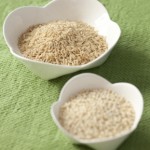Okay, I confess; I didn't know there was such a thing as the NIH-AARP study either. Today I was reading the Wall Street Journal and saw an article titled "Fiber-Rich Diet Linked to Longevity." It mentioned the large ongoing study that I subsequently found online. Back in 1995-96 three and a half million questionnaires were mailed out to AARP members aged 50 to 71 who lived in one of six states (CA, FL, PA, NJ, NC, or LA) or two metropolitan areas (Detroit and Atlanta). Why these particular states and cities were chosen wasn't immediately clear to me.
Roughly one out of seven returned the questionaires, still that's over half a million people and an large number of medical articles have been generated from following this group over the past fifteen years. The stats on the subjects of the study interested me; 60% were male, 90%+ were white, non-Hispanic, only 11 of the men and 15% of the women were current smokers. Body mass index and education levels varied widely.
I read the newspaper article about dietary fiber, tried to get the online article from the Archives of Internal Medicine (they wanted $30 for 24 hour usage of the paper) and then found the (free) NIH release on their MedlinePlus web page.
The report says eating a fiber-rich diet could cut your risk of dying from heart disease, respiratory disease or "other causes" by 22%. The lead author works at the National Cancer Institute and mentions that the 2010 Dietary Guidelines push whole grains, vegetables and fruits. But the study, with over a third of a million participants, said that the fiber from fruits wasn't a factor in the reduced death rates. That doesn't mean we shouldn't eat fresh fruit though.
Fiber has already been linked to lower risks of diabetes, reduced rates of some cancers (liver, bladder, esophagus, kidney, head & neck) and less tendency toward obesity; here it's also associated with a lower mortality rate from heart disease or respiratory disease.
Now a real question, and one asked directly by a dietician/exercise physiologist who commented on the study, is whether those who choose high fiber diets also lead healthier lifestyles (e.g., more exercise, no smoking). That may well be the case, but why not add more whole grains to your own diet? That seemed to be a nugget of nutritional advice that could benefit everyone.
The recommended fiber intake for adults over 50 is 30 grams for men and 21 for women. That's a lot of whole grains and where can we get them? I found a Harvard Medical School list online and copied and pasted it into this post.
- Amaranth
- Barley
- Brown rice
- Bulgur (cracked wheat)
- Whole-wheat pasta or couscous
- Flaxseed
- Millet
- Oats
- Quinoa
- Rye
- Spelt
- Wheat berries
- Wild rice
We cook with some of these (e.g., barley was in the bison, potato, carrot and turnip stew we had this week). We eat brown rice, millet seeds, wild rice, oats and flax seeds on a regular basis (we had a dish of steel-cut oats at breakfast today; most of the rest we've tried at one time or another.
More fiber, especially from whole grains, makes sense. Give it a try.

